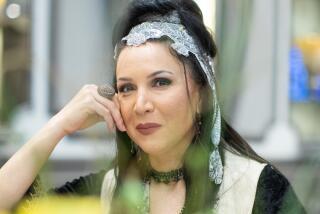She’s got the beat
- Share via
The folklore of Upper Egypt embraces and sometimes fuses a number of traditions: ancient Pharaonic, those belonging to village cultures of the area, others dating from the Ottoman conquest and more recent pan-Muslim influences. To these, Tunisian dancer Leila Haddad added source material (including costuming) from Rajasthan, India, for her varied 90-minute program titled “In the Trail of the Ghawazee” at UCLA’s Royce Hall on Saturday.
In all her dances, Haddad relied on the bedrock authority of seven men billed as the Gypsy Musicians of Upper Egypt, masters of such arcane instruments as the two-string spike fiddle, the drone double clarinet, the open-ended reed flute and drums of all sizes. And her dancing proved most exciting when specifically reflecting the pulse of their accompaniment, whether in rippling arm movements or sharp hip swings.
At one point in her dance with a silver cane -- the most familiar Egyptian folkloric piece on the program -- she briefly draped herself along the large circular drum held by El Kinawy.
At other times, she interacted at length with singer-drummer El Hamy Mohamed and later with singer Youssef Moubarak, who moved behind her and reached forward to bow his fiddle across her chest.
The easy camaraderie and charm of these passages eclipsed Haddad’s more insular solos, in which she unfortunately adopted a forced smile that undercut the spontaneity of her performance -- even the complex but free-spirited muscular isolations that linked the skills of the Ghawazee (Gypsy entertainers) with modern dance technique.
Many of the pieces began with slow, atmospheric musicianship (a hoarse flute, for instance, or those insistent fiddles) that soon accelerated and became structured with the addition of rhythmic drumming and perhaps vocals. Haddad’s contribution reflected the beat through light, quick footwork and torso accents that ranged from generalized shimmers to convulsive pelvic undulations.
Her technical arsenal also included sensuous lateral swaying, smooth spinning that might end in a spiral down to the floor and weightless glides across the stage. And sometimes she’d shatter the sense of flow that she’d worked so hard to sustain with an outburst of shoulder shakes, frantic lashings of her long dreads or a single gesture that served as a kind of exclamation point.
Moving across a darkened stage in layers of gleaming fabric, she embodied all the glamour and fantasy that traveling performers have brought to rural societies through the ages -- the escape from everyday life that we still seek in nearly every kind of entertainment.
Some people might call Haddad a belly dancer, but the term would not only degrade what she performs by linking it to cheap cabaret exhibitionism but also fail to account for the amazing expansions and contractions of the upper torso and chest that she displayed in one solo or those liquid arms in her opening invocation ritual or her intricate articulations of the neck.
Calling her an Oriental dancer would be equally misleading -- you might expect to find her in a kimono or flower-crown headdress instead of the long, veil-like head cloths over either dresses or pantaloon ensembles that she wore Saturday, apparel accented in metallic gold but dominated by various reds and splashes of orange or black.
Call her instead a woman of the world, one who moved to France in her teens but eventually defined herself as an artist who belongs to many cultures and ages, assimilating their beauties and sharing them with us as our own world darkens and needs all the escape it can get.
Besides the musicians previously mentioned, the ensemble included Abdallah Farah, Mohamed Mourad, Ramadan Atta and Gamal Gomaa.
--
More to Read
The biggest entertainment stories
Get our big stories about Hollywood, film, television, music, arts, culture and more right in your inbox as soon as they publish.
You may occasionally receive promotional content from the Los Angeles Times.








